View in other NatureServe Network Field Guides
NatureServe
Montana
Utah
Wyoming
Idaho
Wisconsin
British Columbia
South Carolina
Yukon
California
New York
Woodland Skipper - Ochlodes sylvanoides
Native Species
Global Rank:
G5
State Rank:
S5
Agency Status
USFWS:
USFS:
BLM:
External Links
General Description
[From Ferris and Brown 1981; Scott 1986; Layberry et al. 1998; Opler and Wright 1999; Glassberg 2001; Pyle 2002] Forewing 1.3-1.5 cm. Uppersurface tawny orange, lacking white spots but with dark brown border projecting inward between veins, male forewing with prominent black stigma imbedded in dark diagonal band from wing base to somewhat rounded tip, female forewing with a dark diagonal band and no stigma. Undersurface variable (yellow, purple, chocolate-brown), hindwing usually yellow-orange with postmedian chevron of pale squarish yellow or yellow-cream spots.
Phenology
One flight, mostly late July through August (late August to early October in California); multiple flights April to October at lower elevation in California (Scott 1986). Mid-June to early October, mainly August through September (Glassberg 2001). June to September in Canada (Layberry et al. 1998). Mid-July through August in the Rocky Mountain states (Ferris and Brown 1981), mid-July to late September in Colorado (Scott and Epstein 1987), mid-August to mid-September in the Black Hills of South Dakota (McCabe and Post 1976), mid-June to early October in Oregon and Washington (Pyle 2002), late June to early October in Oregon (Warren 2005), late July to mid-September in British Columbia (Threatful 1988; Guppy and Shepard 2001).
Diagnostic Characteristics
Best determined by a combination of the uppersurface with dark brown border projecting inward (tooth-like) between veins, both sexes with a dark diagonal band from wing base to tip, encompassing a prominent black stigma in the male; undersurface of the hindwing variable in color, usually yellow-orange with postmedian chevron of pale and large squarish yellow or yellow-cream spots.
Species Range
Montana Range
Range Descriptions
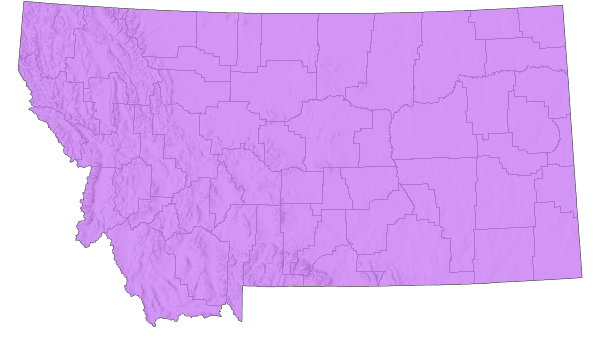
 Native
Native
Range Comments
Central British Columbia, southern Alberta, southwestern Saskatchewan south to northern Baja California, central Nevada, northern Arizona, northern New Mexico, east to western North Dakota, western South Dakota, Colorado (Ferris and Brown 1981; Scott 1986, Layberry et al. 1998; Opler and Wright 1999; Glassberg 2001; expanded northward in Alberta during the past 20 years (Bird et al. 1995); typically to 2600 m elevation in the Rocky Mountain states (Ferris and Brown 1981), to 3353 m elevation in Colorado (Brown 1957), to at least 2075 m elevation in northern California (Emmel and Emmel 1962), sea level to at least 2134 m elevation in Oregon (Warren 2005), sea level to about 1000 m elevation in British Columbia (Threatful 1988; Guppy and Shepard 2001). In Montana, reported from at least 45 counties throughout the state (Kohler 1980; Stanford and Opler 1993; FLMNH Lepidopterists' Society database), to at least 1600 m elevation. Common to abundant (Glassberg 2001).
Observations in Montana Natural Heritage Program Database
Number of Observations: 70
(Click on the following maps and charts to see full sized version)
Map Help and Descriptions
Relative Density
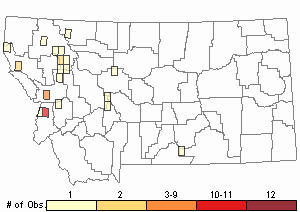
Recency
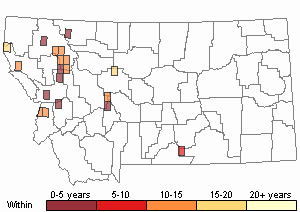
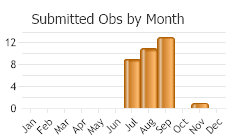
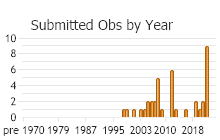
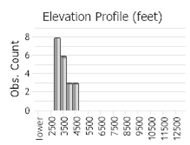 (Observations spanning multiple months or years are excluded from time charts)
(Observations spanning multiple months or years are excluded from time charts)
Migration
Non-migratory.
Habitat
Hillsides, grassy areas in chaparral, sagebrush, montane meadows, gardens, along streams and roadways (Scott 1986; Threatful 1988; Opler and Wright 1999; Glassberg 2001; Pyle 2002; Warren 2005). Habitat in Montana not described but probably similar.
National Vegetation Classification System Groups Associated with this Species
Forest and Woodland
Low Elevation - Xeric Forest and Woodland
Montane - Subalpine Forest and Woodland
Shrubland
Foothills - Montane Shrubland
Sagebrush Shrubland
Grassland
Lowland - Prairie Grassland
Montane - Subalpine Grassland
Wetland and Riparian
Riparian and Wetland Forest
Riparian Shrubland
Food Habits
Larval food plants are native and exotic grasses, including Agropyron (several species), Agrostis (multiple species), Avena, Bromus (several species), Cynodon, Dactylis, Danthonia, Elymus (multiple species), Leucanthemum, Leucopoa, Leymus (several species), Muhlenbergia, Phalaris (multiple species), Phleum, Pseudoroegneria, possibly Calamagrostis, and Poa in captivity (Scott 1986, 1992, 2006; Pyle 2002; Graves and Shapiro 2003; Warren 2005; James and Nunnallee 2011); anomalous oviposition reported on the shrub Ceanothus cuneatus (Shapiro 2013). Adults feed on flower nectar (including Achillea, Alyssum, Anaphalis, Arctium, Asclepias, Astragalus, Berteroa, Buddleia, Carduus, Centaurea, Cerastium, Chamaenerion, Chrysanthemum, Chrysothamnus, Cichorium, Cirsium, Dipsacus, Epilobium, Ericameria, Erigeron, Eriogonum, Geranium, Grindelia, Helianthus, Heterotheca, Lathyrus, Lavandula, Leontodon, Liatris, Linaria, Lythrum, Machaeranthera, Medicago, Mentha, Monarda, Nepeta, Phlox, Polygonum, Prunella, Solidago, Sonchus, Symphyotrichum, Tagetes, Tanacetum, Trifolium, Verbena, Viguiera, Zinnia) and mud (Scott 1986, 2014; Pyle 2002; Warren 2005; Shapiro 2013).
Reproductive Characteristics
Females lay eggs singly on the undersides of dead host plant leaves, typically 10-60 cm above ground (Scott 1992; James and Nunnallee 2011). L1 instar hatches from egg in about 7-18 days (depending on temperature), L1 instar overwinters in silk-tied leaf-tube shelter, emerges from diapause in spring, develop from L1 instar to L5 instar and pupa in about 44 days, adults eclose (emerge from pupae) in about 6-10 days. Larvae depart nests to feed on host plant leaves, feed nocturnally but may become more active during day as larvae mature, mature (L5 instar) larvae may aestivate for about 30 days prior to pupation, pupates in new leaf-nest (Scott 1979, 1986; James and Nunnallee 2011). Males perch throughout the day about 1 m above ground in gullies, valley botttoms, among shrubs on ridges, awaiting passing females (Scott 1975b, 1986).
Stewardship Responsibility
References
- Literature Cited AboveLegend:
 View Online Publication
View Online Publication Bird, C.D., G.I. Hilchie, N.G. Kondla, E.M. Pike, and F.A.H. Sperling. 1995. Alberta Butterflies. The Provincial Museum of Alberta, Edmonton. 349 pp.
Bird, C.D., G.I. Hilchie, N.G. Kondla, E.M. Pike, and F.A.H. Sperling. 1995. Alberta Butterflies. The Provincial Museum of Alberta, Edmonton. 349 pp. Emmel, T.C. and J.F. Emmel. 1962. Ecological studies of Rhopalocera in a High Sierran Community-Donner Pass, California. I. Butterfly associations and distributional factors. Journal of the Lepidopterists' Society 16:23-44.
Emmel, T.C. and J.F. Emmel. 1962. Ecological studies of Rhopalocera in a High Sierran Community-Donner Pass, California. I. Butterfly associations and distributional factors. Journal of the Lepidopterists' Society 16:23-44. Ferris, C.D. and F.M. Brown (eds). 1981. Butterflies of the Rocky Mountains. Univ. of Oklahoma Press. Norman. 442 pp.
Ferris, C.D. and F.M. Brown (eds). 1981. Butterflies of the Rocky Mountains. Univ. of Oklahoma Press. Norman. 442 pp. Glassberg, J. 2001. Butterflies through Binoculars: A Field Guide to the Butterflies of Western North America. Oxford University Press.
Glassberg, J. 2001. Butterflies through Binoculars: A Field Guide to the Butterflies of Western North America. Oxford University Press. Graves, S.D. and A.M. Shapiro. 2003.Exotics as host plants of the California butterfly fauna. Biological Conservation 110: 413-433.
Graves, S.D. and A.M. Shapiro. 2003.Exotics as host plants of the California butterfly fauna. Biological Conservation 110: 413-433. Guppy, C.S. and J.H. Shepard. 2001. Butterflies of British Columbia: including western Alberta, southern Yukon, the Alaska Panhandle, Washington, northern Oregon, northern Idaho, northwestern Montana. UBC Press (Vancouver, BC) and Royal British Columbia Museum (Victoria, BC). 414 pp.
Guppy, C.S. and J.H. Shepard. 2001. Butterflies of British Columbia: including western Alberta, southern Yukon, the Alaska Panhandle, Washington, northern Oregon, northern Idaho, northwestern Montana. UBC Press (Vancouver, BC) and Royal British Columbia Museum (Victoria, BC). 414 pp. James, D.G. and D. Nunnallee. 2011. Life histories of Cascadia butterflies. Corvallis, OR: Oregon State University Press. 447 p.
James, D.G. and D. Nunnallee. 2011. Life histories of Cascadia butterflies. Corvallis, OR: Oregon State University Press. 447 p. Kohler, S. 1980. Checklist of Montana Butterflies (Rhopalocera). Journal of the Lepidopterists' Society 34(1): 1-19.
Kohler, S. 1980. Checklist of Montana Butterflies (Rhopalocera). Journal of the Lepidopterists' Society 34(1): 1-19. Layberry, R.A., P.W. Hall, and J.D. LaFontaine. 1998. The Butterflies of Canada. University of Toronto Press. 280 pp. + color plates.
Layberry, R.A., P.W. Hall, and J.D. LaFontaine. 1998. The Butterflies of Canada. University of Toronto Press. 280 pp. + color plates. McCabe, T.L. and R.L. Post. 1976. North Dakota butterfly calendar (including possible strays). Journal of Research on the Lepidoptera 15:93-99.
McCabe, T.L. and R.L. Post. 1976. North Dakota butterfly calendar (including possible strays). Journal of Research on the Lepidoptera 15:93-99. Opler, P.A. and A.B. Wright. 1999. A field guide to western butterflies. Second edition. Peterson Field Guides. Houghton Mifflin Company, Boston, Massachusetts. 540 pp.
Opler, P.A. and A.B. Wright. 1999. A field guide to western butterflies. Second edition. Peterson Field Guides. Houghton Mifflin Company, Boston, Massachusetts. 540 pp. Opler, P.A., K. Lotts, and T. Naberhaus, coordinators. 2010. Butterflies and moths of North America. Big Sky Institute, Bozeman, MT. Available at: www.butterfliesandmoths.org (Accessed 15 June 2015).
Opler, P.A., K. Lotts, and T. Naberhaus, coordinators. 2010. Butterflies and moths of North America. Big Sky Institute, Bozeman, MT. Available at: www.butterfliesandmoths.org (Accessed 15 June 2015). Pyle, R.M. 2002. The butterflies of Cascadia: a field guide to all the species of Washington, Oregon, and surrounding territories. Seattle Audubon Society, Seattle, Washington. 420 pp.
Pyle, R.M. 2002. The butterflies of Cascadia: a field guide to all the species of Washington, Oregon, and surrounding territories. Seattle Audubon Society, Seattle, Washington. 420 pp. Scott, J.A. 1975b. Mate-locating behavior of western North American butterflies. Journal of Research on the Lepidoptera 14:1-40.
Scott, J.A. 1975b. Mate-locating behavior of western North American butterflies. Journal of Research on the Lepidoptera 14:1-40. Scott, J.A. 1979. Hibernal diapause of North American Papilionoidea and Hesperioidea. Journal of Research on the Lepidoptera 18(3): 171-200.
Scott, J.A. 1979. Hibernal diapause of North American Papilionoidea and Hesperioidea. Journal of Research on the Lepidoptera 18(3): 171-200. Scott, J.A. 1986. The butterflies of North America: a natural history and field guide. Stanford University Press, Stanford, California.
Scott, J.A. 1986. The butterflies of North America: a natural history and field guide. Stanford University Press, Stanford, California. Scott, J.A. 1992. Hostplant records for butterflies and skippers (mostly from Colorado) 1959-1992, with new life histories and notes on oviposition, immatures, and ecology. Papilio new series #6. 185 p.
Scott, J.A. 1992. Hostplant records for butterflies and skippers (mostly from Colorado) 1959-1992, with new life histories and notes on oviposition, immatures, and ecology. Papilio new series #6. 185 p. Scott, J.A. 2006. Butterfly hostplant records, 1992-2005, with a treatise on the evolution of Erynnis, and a note on new terminology for mate-locating behavior. Papilio new series #14. 74 p.
Scott, J.A. 2006. Butterfly hostplant records, 1992-2005, with a treatise on the evolution of Erynnis, and a note on new terminology for mate-locating behavior. Papilio new series #14. 74 p. Scott, J.A. 2014. Lepidoptera of North America 13. Flower visitation by Colorado butterflies (40,615 records) with a review of the literature on pollination of Colorado plants and butterfly attraction (Lepidoptera: Hersperioidea and Papilionoidea). Contributions of the C.P. Gillette Museum of Arthopod Diversity. Fort Collins, CO: Colorado State University. 190 p.
Scott, J.A. 2014. Lepidoptera of North America 13. Flower visitation by Colorado butterflies (40,615 records) with a review of the literature on pollination of Colorado plants and butterfly attraction (Lepidoptera: Hersperioidea and Papilionoidea). Contributions of the C.P. Gillette Museum of Arthopod Diversity. Fort Collins, CO: Colorado State University. 190 p. Scott, J.A. and M.E. Epstein. 1987. Factors affecting phenology in a temperate insect community. American Midland Naturalist 117(1): 103-118.
Scott, J.A. and M.E. Epstein. 1987. Factors affecting phenology in a temperate insect community. American Midland Naturalist 117(1): 103-118. Shapiro, A.M. 2013. Oviposition on a shrubby dicot by Ochlodes sylvanoides (Boisduval)(Hesperiidae). Journal of the Lepidopterists' Society 68:65-66.
Shapiro, A.M. 2013. Oviposition on a shrubby dicot by Ochlodes sylvanoides (Boisduval)(Hesperiidae). Journal of the Lepidopterists' Society 68:65-66. Stanford, R.E. and P.A. Opler. 1993. Atlas of western USA butterflies: including adjacent parts of Canada and Mexico. Unpubl. Report. Denver and Fort Collins, Colorado 275 pp.
Stanford, R.E. and P.A. Opler. 1993. Atlas of western USA butterflies: including adjacent parts of Canada and Mexico. Unpubl. Report. Denver and Fort Collins, Colorado 275 pp. Threatful, D.L. 1988. A list of the butterflies and skippers of Mount Revelstoke and Glacier National Parks, British Columbia, Canada (Lepidoptera). Journal of Research on the Lepidoptera 27(3-4): 213-221.
Threatful, D.L. 1988. A list of the butterflies and skippers of Mount Revelstoke and Glacier National Parks, British Columbia, Canada (Lepidoptera). Journal of Research on the Lepidoptera 27(3-4): 213-221. Warren, A.D. 2005. Lepidoptera of North America 6: Butterflies of Oregon, their taxonomy, distribution, and biology. Contributions of the C. P. Gillette Museum of Arthropod Diversity, Colorado State University. Fort Collins, Colorado. 406 pp.
Warren, A.D. 2005. Lepidoptera of North America 6: Butterflies of Oregon, their taxonomy, distribution, and biology. Contributions of the C. P. Gillette Museum of Arthropod Diversity, Colorado State University. Fort Collins, Colorado. 406 pp.
- Additional ReferencesLegend:
 View Online Publication
View Online Publication
Do you know of a citation we're missing? Allen, T.J., J.P. Brock, and J. Glassberg. 2005. Caterpillars in the field and garden: a field guide to the butterfly caterpillars of North America. Oxford University Press.
Allen, T.J., J.P. Brock, and J. Glassberg. 2005. Caterpillars in the field and garden: a field guide to the butterfly caterpillars of North America. Oxford University Press. Brock, J.P. and K. Kaufman. 2003. Kaufman Field Guide to Butterflies of North America. Houghton Mifflin Company, New York, NY 284 pp.
Brock, J.P. and K. Kaufman. 2003. Kaufman Field Guide to Butterflies of North America. Houghton Mifflin Company, New York, NY 284 pp. Forister, M.L., C.A. Halsch, C.C. Nice, J.A. Fordyce, T.E. Dilts, J.C. Oliver, K.L. Prudic, A.M. Shapiro, J.K. Wilson, J. Glassberg. 2021. Fewer butterflies seen by community scientists across the warming and drying landscapes of the American West. Science 371:1042-1045.
Forister, M.L., C.A. Halsch, C.C. Nice, J.A. Fordyce, T.E. Dilts, J.C. Oliver, K.L. Prudic, A.M. Shapiro, J.K. Wilson, J. Glassberg. 2021. Fewer butterflies seen by community scientists across the warming and drying landscapes of the American West. Science 371:1042-1045. Forister, M.L., E.M. Grames, C.A. Halsch, K.J. Burls, C.F. Carroll, K.L. Bell, J.P. Jahner, et al. 2023. Assessing risk for butterflies in the context of climate change, demographic uncertainty, and heterogeneous data sources. Ecological Monographs 93(3):e1584. https://doi.org/10.1002/ecm.1584
Forister, M.L., E.M. Grames, C.A. Halsch, K.J. Burls, C.F. Carroll, K.L. Bell, J.P. Jahner, et al. 2023. Assessing risk for butterflies in the context of climate change, demographic uncertainty, and heterogeneous data sources. Ecological Monographs 93(3):e1584. https://doi.org/10.1002/ecm.1584 Sater, S. 2022. The insects of Sevenmile Creek, a pictorial guide to their diversity and ecology. Undergraduate Thesis. Helena, MT: Carroll College. 242 p.
Sater, S. 2022. The insects of Sevenmile Creek, a pictorial guide to their diversity and ecology. Undergraduate Thesis. Helena, MT: Carroll College. 242 p.
- Web Search Engines for Articles on "Woodland Skipper"
- Additional Sources of Information Related to "Insects"





